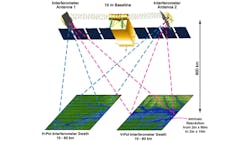Water Topography Mission Utilizes Ka-Band Radar Interferometer
Assessing the impact of climate change on freshwater resources—a rapidly growing concern on a global scale—requires comprehensive measurements. Gathering such information from space is the best method, but as of now, measurements are taken on only 15% of lakes around the world.
By using wide swath altimetry technology to gather high-resolution elevation measurements of ocean and other water surfaces, the Surface Water and Ocean Topography (SWOT) mission aims to survey Earth’s surface water and map ocean surface height with greater detail than previously recorded.
A soon-to-be-developed spacecraft, coming from a joint project between NASA and the French space agency Centre National d'Études Spatiales (CNES), will contain instruments to measure the ocean’s surface at 10 times the resolution of current technologies. Key among the instruments is the Ka-band radar interferometer (KaRIn) provided by NASA. KaRIn contains two Ka-band synthetic-aperture radar (SAR) antennas, both of which transmit and receive the emitted radar pulses. Its wide swath is able to cover all of the planet’s lakes, rivers, reservoirs, and oceans at least twice every 21 days.
NASA will also supply the SWOT payload module, a microwave radiometer (MR) replete with antenna, a laser retro-reflector array, a GPS receiver payload, ground support, and launch services. CNES will provide the spacecraft bus, the KaRIn instrument’s radio-frequency-unit (RFU), a dual-frequency Ku/C-band nadir altimeter, a Doppler orbitography and radio-positioning integrated-by-satellite (DORIS) receiver package, satellite command and control, and data-processing infrastructure. The two agencies began initial studies for the mission in 2009 and plan to complete preliminary design activities in 2016, with a planned launch in 2020.
About the Author
Iliza Sokol
Associate Digital Editor
Iliza joined the Penton Media group in 2013 after graduating from the Fashion Institute of Technology with a BS in Advertising and Marketing Communications. Prior to joining the staff, she worked at NYLON Magazine and a ghostwriting firm based in New York.
